This sixth and final review post below, is about using sheer fabrics: netting, tulle, and other semi-transparent fabrics. I often use these near the end of the collage process to add more detail or a spot of color or splash of something shiny—you can see some of those fabrics being auditioned in the fish photo above. I just love working with these translucent and decorative fabrics and think you will, too. A chance to play with (and collect!) another sort of fabric!
After a short and sweet break from teaching fabric collage over the holidays, my schedule is heating up again. Next week begins our five-day January 2025 Live Online Class, then three weeks from today starts my Fantastical Fish Follow-Along Zoom class. In preparation for that Fish Follow-Along (or any other 2025 class or just a fresh fabric collage start to the new year), we’ve been publishing this review of the basics of the fabric collage technique. Previously we covered choosing fabric, creating a palette for fabric collage, gluing, working in sequence, and backgrounds.
* * * * * *
The Fantastical Fish Follow Along in February, will use a fish pattern (of your own design or one which you may choose from my collection) with a 2025 focus on “blending”—one of my most asked about skills—the process of using the colors, values, and prints in fabrics to merge one into another, often to create the illusion of form, with highlights and shadows.
The Bugs and Butterflies Follow Along in June and July (also your own design or based on my patterns), will focus on butterflies and how to approach the flowing and colorful shapes of their fascinating wings. Learn what to look for in your fabrics and how to work with their printed designs to create movement and form—letting the fabric do much of the work for you.
Use the links below to register for these four-week classes, held each Thursday night at 7:00 p.m. eastern time.
In the meantime, especially if you are new to fabric collage, it may be helpful to review the basics through all six of our Fabric Collage Review series of posts (see links above) covering the fabric collage technique before these classes begin.
* * * * * *
February 6, 13, 20, 27, 2025 — 7 pm, Eastern Time
Fantastical Fabric Collage Fish Zoom Follow-Along
REGISTER HERE
Price: $78
* * * * * *
July 24, 31, August 7, 14, 2025 — 7 pm, Eastern Time
Fascinating Fabric Collage Bugs and Butterflies Zoom Follow-Along
REGISTER HERE
Price: $78
Further Susan Carlson Learning Resources: Susan Carlson Quilts website, patterns, blog (in general), YouTube videos, Spiral eWorkshop, Patreon, and our February Fantastical Fish and Summertime’s Fascinating Bugs and Butterfly Work-Alongs
Using Sheer, Netting, and other Semi-Transparent Fabrics
First published January 7, 2017.
It isn’t always clear to those who haven’t seen my work in person how much netting, tulle and other semi-transparent fabric I use in my quilts. For simplicity’s sake I’m going to call them all sheers (even though sheer is a type of fabric itself).
I use these fabrics near the end—or final draft—of my piecing to add a final layer of detail. They’re one of the last things I consider, obviously, because they’re transparent and need to be placed on top of other fabric—such as the collaged image.
Sheers serve several purposes. I use them to create highlights and shadows. They can be used to smooth the transition between fabrics. And they add visual interest, some glitz, when needed. In other words, they change, without completely overpowering, the look of the fabric underneath. The effect can be subtle or it can be striking.
Netting, lace, organza, chiffon, tulle (also called bridal illusion)—I use it all. I have literally dozens of them in different colors, prints, weights. They tend to be polyester, which is usually quite inexpensive, making them doubly hard to resist.
And—surprise, surprise—I prefer to use sheers that have a print in them. Plain netting is okay, but why use it when there are so many with delicious prints to choose from that can help define form or add interest. I am especially fond of flocked netting or netting studded with glitter.
Many people who saw “Crocodylus Smylus” in Houston at the International Quilt Festival remarked that they hadn’t known how much “bling” I had used in creating her. It’s hard to see except in person as many photographs don’t pick it up. Most of it was added using glitter-studded netting.
I don’t use sheers in all my pieces. I’m thinking especially of “Dixie Dingo Dreaming,” the portrait of my dog Pippin, in which I used no sheers at all. I had a couple reasons for abstaining. First, I had made it my goal to use only Aboriginal-themed (cotton print) fabrics—to fit with the “dingo” Australian theme. Second, I used no glitzy materials because Pippin wasn’t a glitzy sort of dog. She was a more of a roll-in-dead-fish sort of dog.
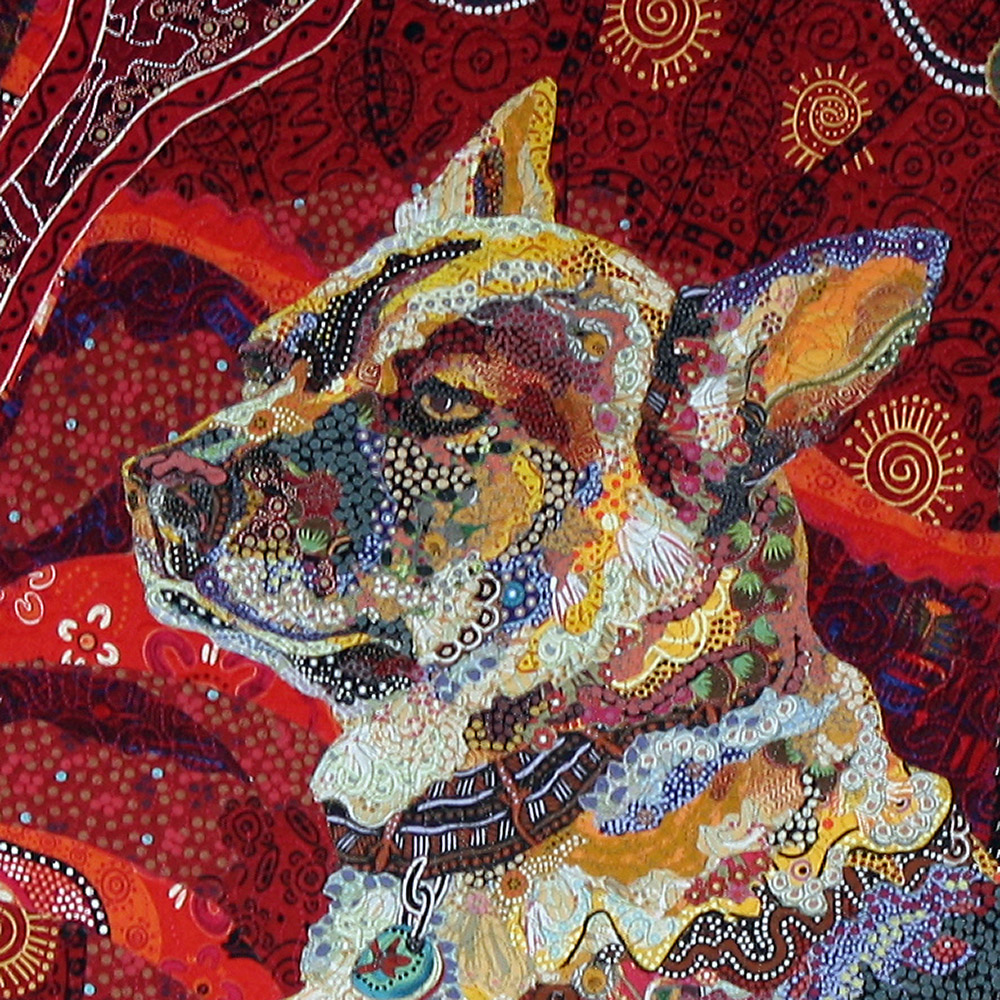
On the other hand, “Golden Temple of the Good Girls” has a fair amount of sparkle. They’re all girls, they are our princesses, so adding sparkle seemed like a natural thing to do.
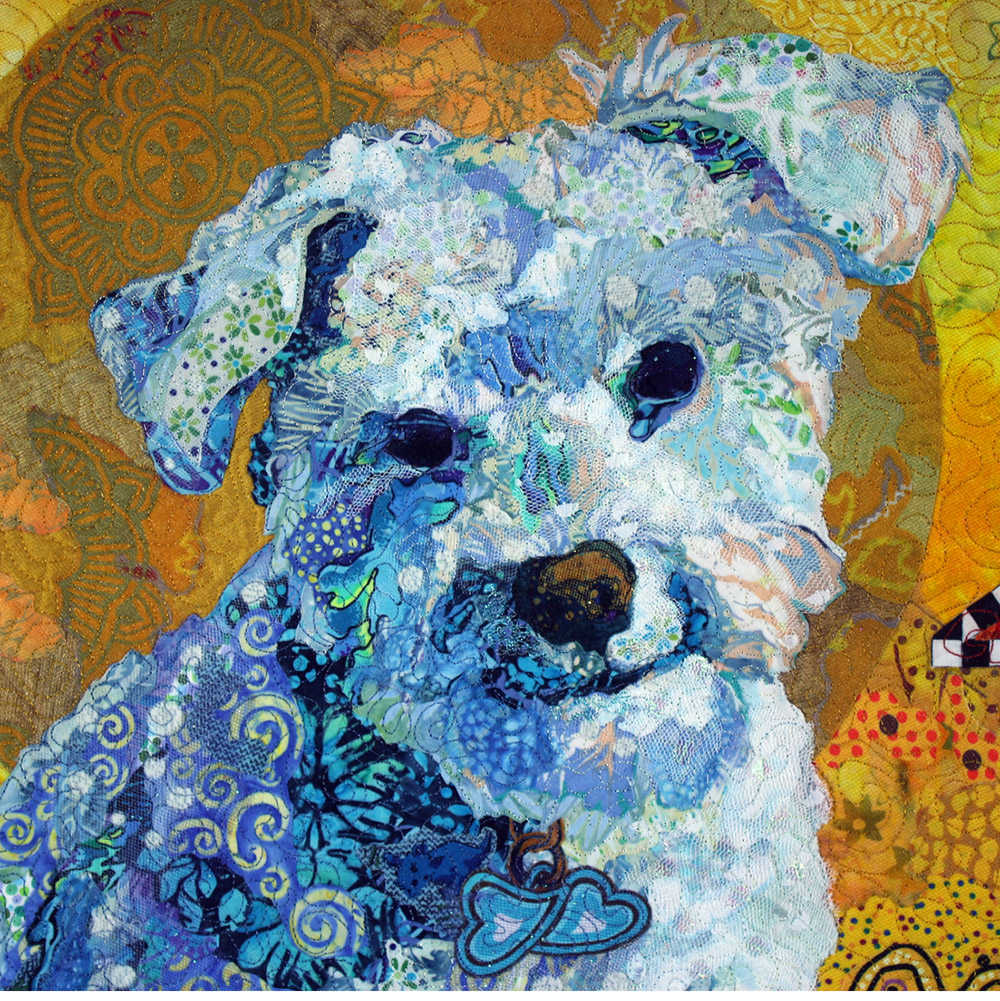
An Example
As I said earlier, I basically use sheers in four ways. I’ve already demonstrated in the above video how I used glitz in Stevie the crocodile, so I’ll use another quilt, “Polka Dodo,” to show examples of the other three ways sheers can be used—though glitz was definitely a big part of his look.
To add glitz- To add highlights
- To add shadows
- To soften or blend fabrics
First the quilt:
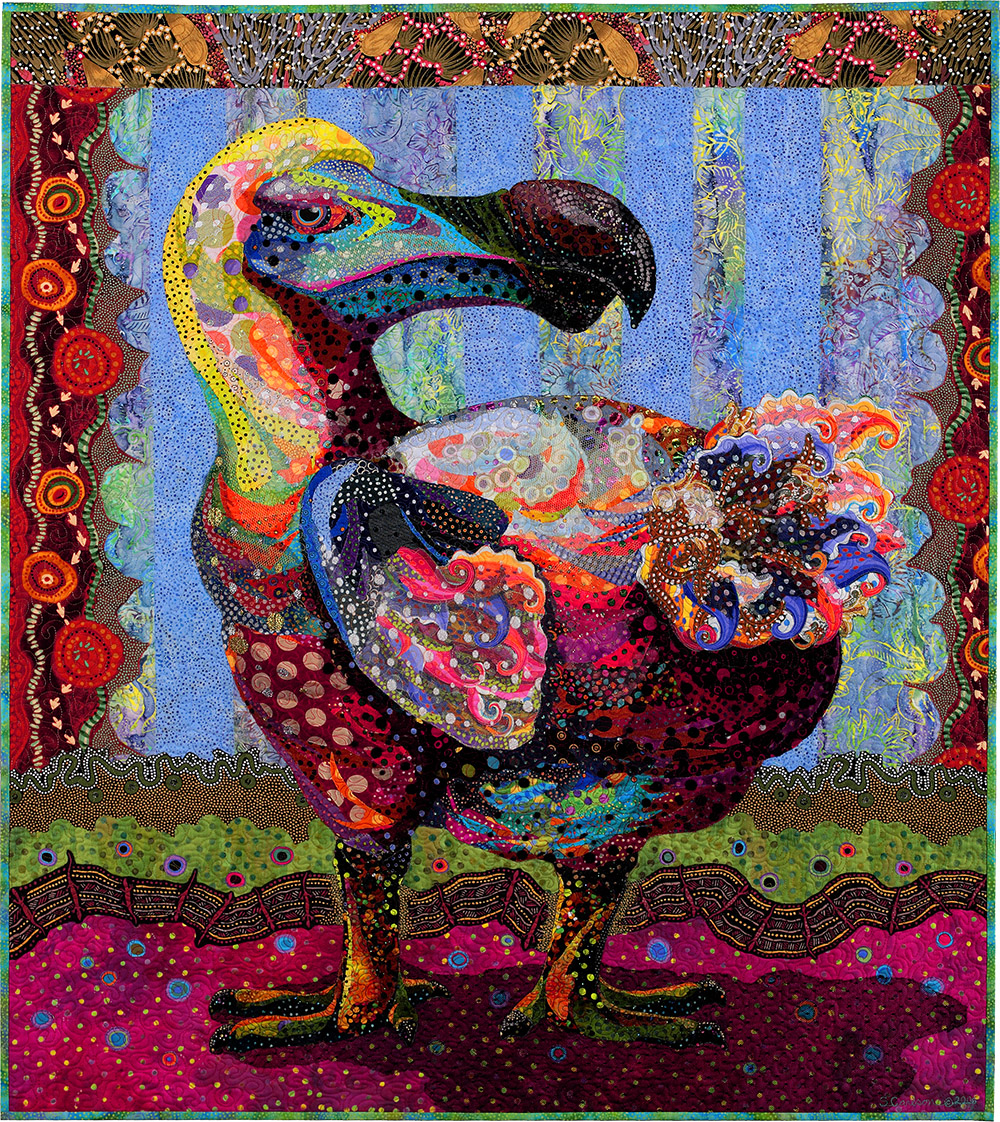
There’s a lot of dimensionality to “Polka Dodo.” At least there’s a lot of dimensionality to the finished piece. Take a look at the quilt before any sheers were applied.

Now look at his head after I used sheers to add highlights with some white spotted netting. By the way, I set myself the challenge of using only polka dotted fabrics—including the sheers—in “Polka Dodo.”
Look at the light sheers on the neck, head and cheek. The use of light sheers helps to bring that part of the image forward. I also used it on his back, as if the light were shining from above. Notice that much of the sheer is not simple netting, but is iridescent or metallic polka dots. The same is true of the shadow on the lower jaw and neck. Those black polka dots are actually black flocked netting.
Let’s move on to using sheers for shadows in other parts of the quilt.
The shadow under his feet is a successful and simple use of sheer fabric. A medium weight netting embedded with tiny polka dots overlays the area defining Dodo’s shadow, shading the underlaying fabric, just like a shadow would in real-life. It’s difficult to see but there is also a dark sheer under his floofy tail and around his wing. In both cases, creating a shadow helped to define those body parts and bring them visually forward.
Finally, and perhaps least obvious is the use of sheers to blend. Look at the white polka-dotted sheer on top of the wing.
To my mind, the wing was too complicated before. Interesting as it was, all those individual pieces of fabric competed for attention with one another. I needed to unify them somehow so the viewer saw “wing” before they saw “curly blue and pink feathers.” The white spotted sheer overlaying the wing helps to lower the contrast between the feathers. It blends them together to accentuate the stubby wing shape. (It also lightened the overall color of the wing, bringing it forward and helping to separate it visually from the body.)
How To
In class, when we get to the stage of adding sheers, my students don’t know how to proceed. How is it done? Do you really just keep on using glue?
Yes.
It takes a little finesse but glue gets the job done. Cut the sheer just as you would cut any fabric for fabric collage, to the exact shape you want it. Rather than applying the glue to the sheer, put a few dabs (not a glop or line) of glue on the fabric you want to adhere the sheer to. Then smear the glue with your finger until you can no longer see it. At that point, the glue is still tacky enough to stick the sheer to it. When applying sheers, I tell my students to use a consciously lighter touch with the glue.
Then, of course, your quilting will hold the sheers—and all your fabrics—in place.
No Discrimination
I hope this post drives home the fact that any fabric can be used for fabric collage. Some may be more useful than others, but your imagination shouldn’t be limited by believing that you can only use cottons or only use opaque fabrics. There are no rules, which can be unsettling at first. Keep at it. You’ll get used to it.
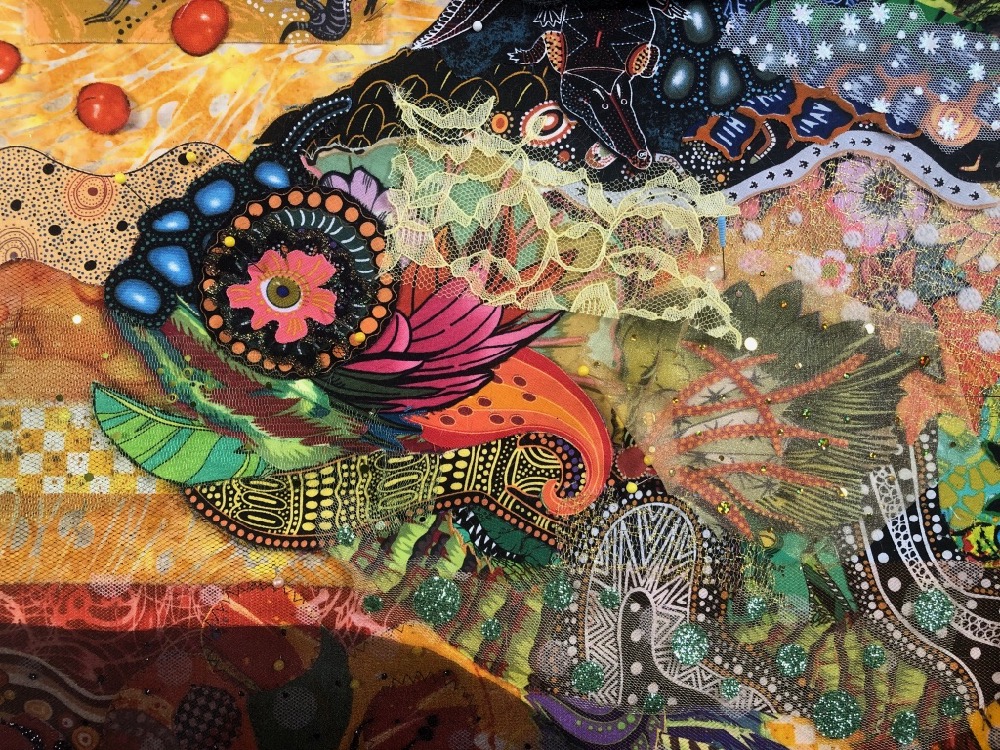


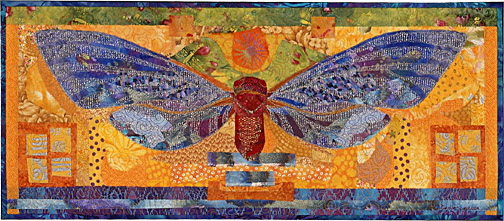
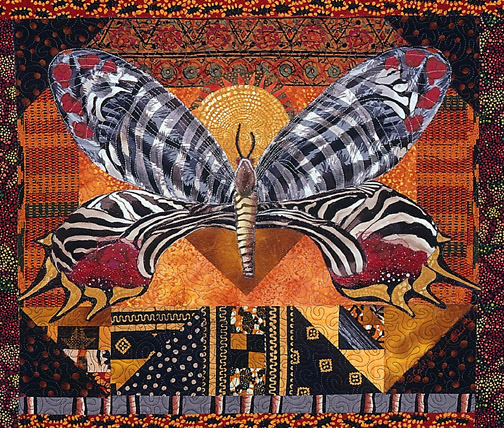
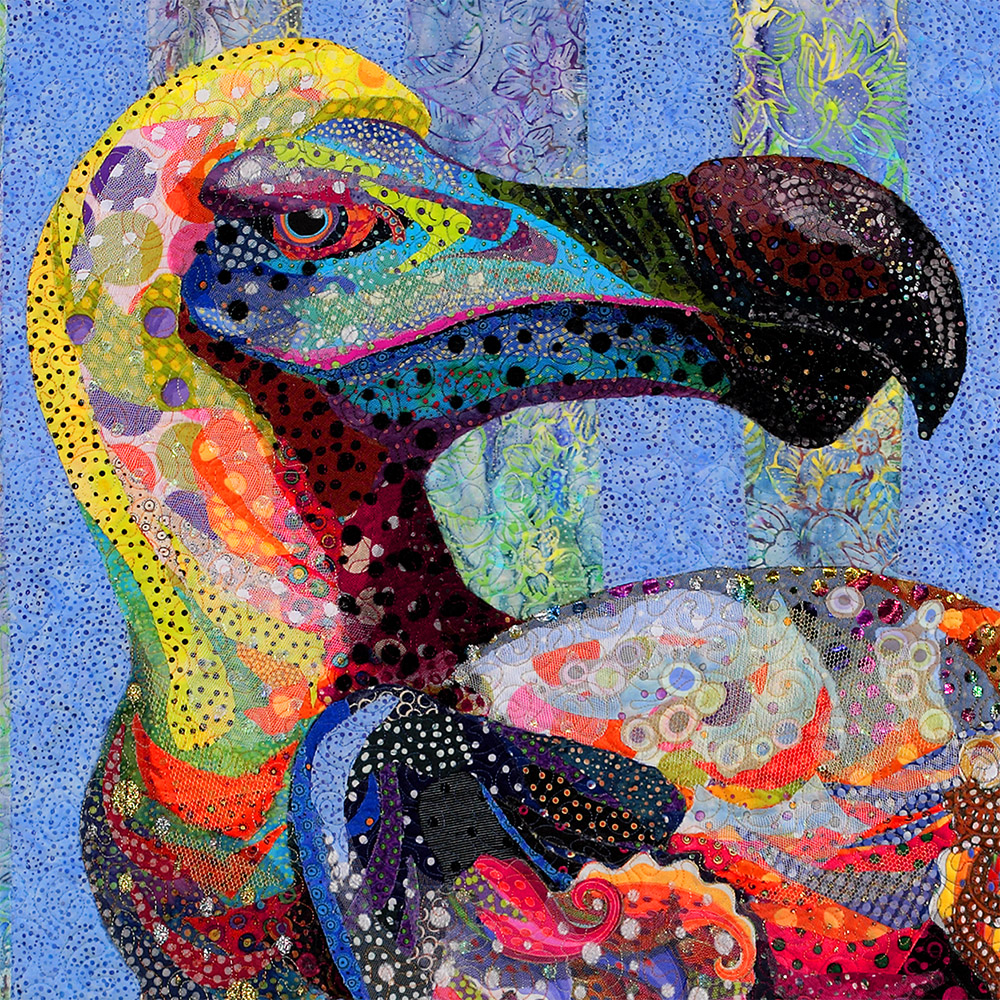
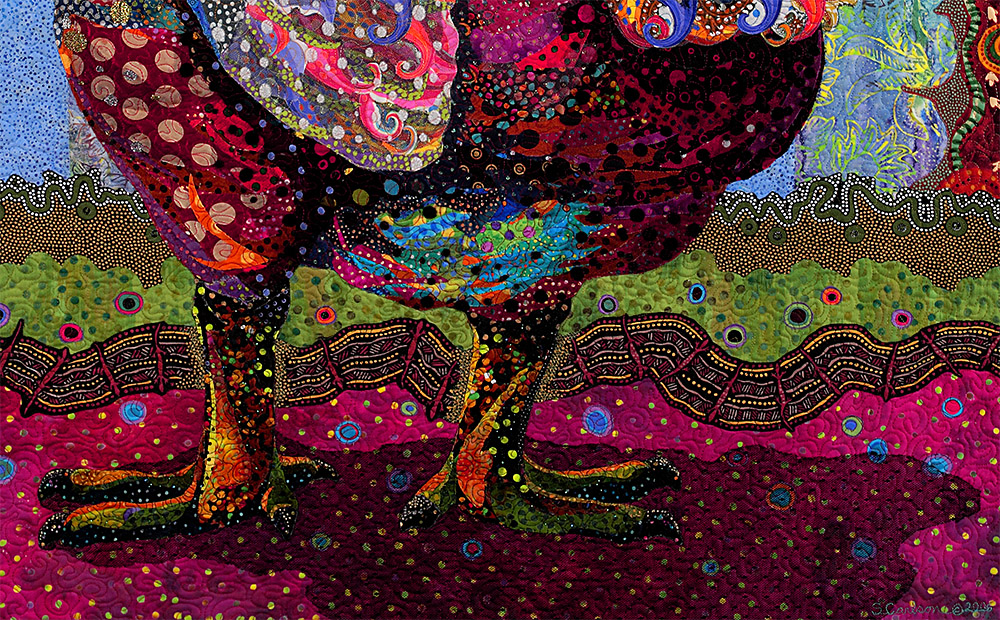
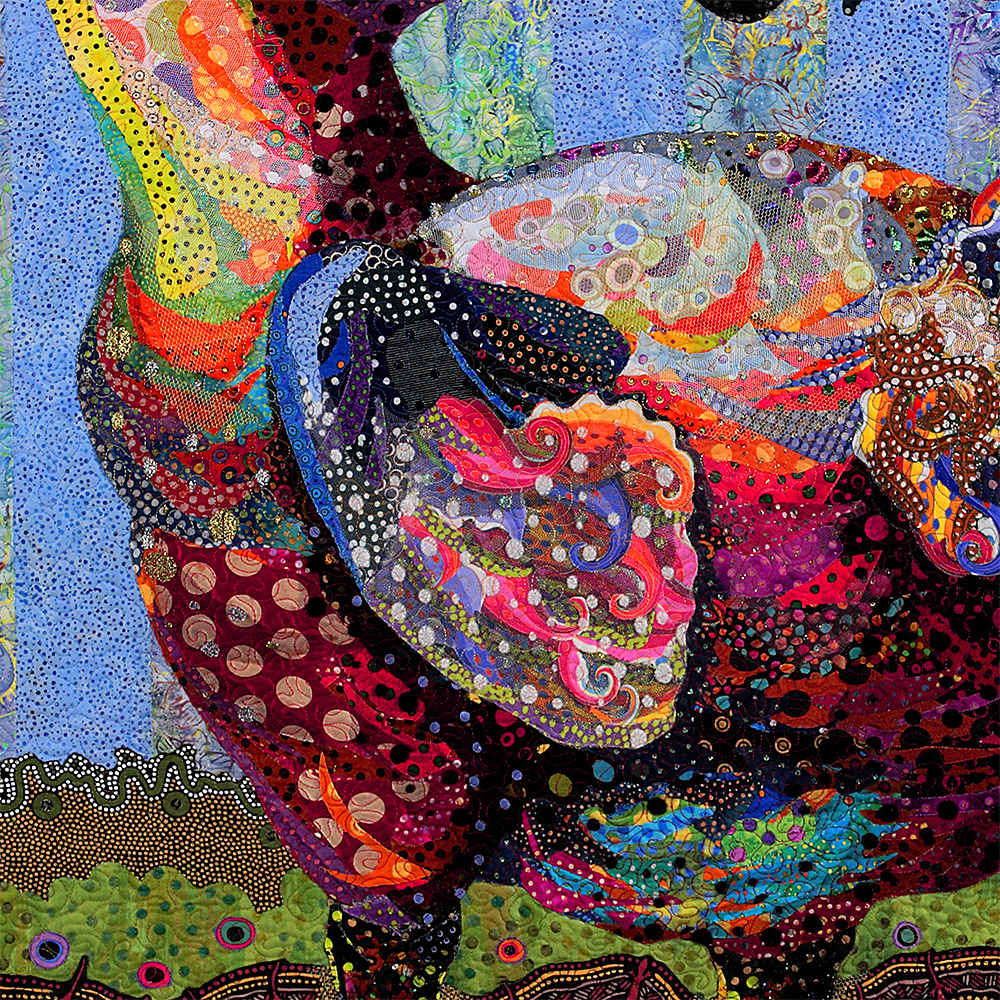
One Comment